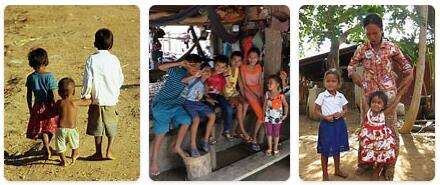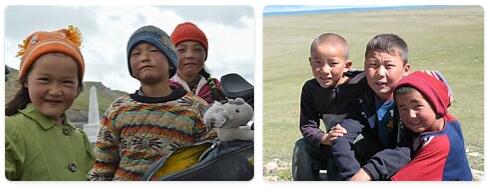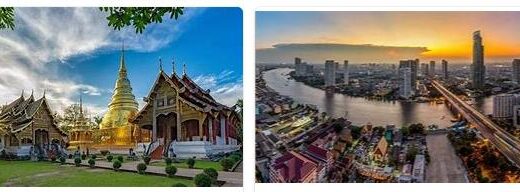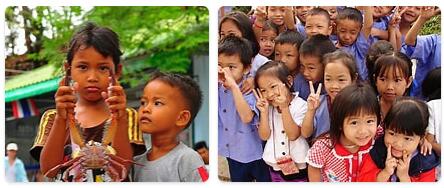Cambodia 2014
Yearbook 2014
Cambodia. The political stalemate that arose after the disputed elections in 2013 was broken at the end of July. The opposition party CNRP (Cambodia’s National Rescue Party) announced that it would suspend its 10-month boycott of Parliament’s work, but did not get through its original demand for re-election. Party leader Sam Rainsy and Prime Minister Hun Sen from the ruling CCP (Cambodian People’s Party) also agreed on changes to the Election Commission. The two parties would appoint four members each and jointly appoint a ninth member. At the end of the year negotiations on the composition of the Commission stalled.
The agreement gave the CNRP the post of the first Deputy Speaker of Parliament and the chairmanship of five committees. The Government Party received the Finance Committee and the Defense and Justice Committees. The 55 elected CNRP members swore their oath of office in August before King Norodom Sihamoni. Rainsy, who did not have a candidacy in 2013, also got a place.
The budget for 2015 was adopted at the end of November. The opposition boycotted the debate and felt that the budget was inadequate. The defense, the Ministry of the Interior and the Ministry of Education received the largest grants.
Cambodia population in 2020 is estimated at 16,718,976. Workers in the important textile industry, which accounts for about 80% of the country’s exports, continued to demand higher minimum wages.

In January, at least five people were shot dead, dozens injured and 23 arrested on the outskirts of the capital Phnom Penh when security forces were deployed against demonstrative textile workers. The government also banned public collections. The ban on demonstration was eased somewhat after a month, but human rights groups criticized that no one was held responsible for the shooting deaths. Five activists were indicted in September for violence and vandalism in connection with the protests. They risk 14 years in prison.
As part of the agreement with CCP, seven CNRP members who were jailed on July 15 were released when they demanded that demonstrations be allowed again in the Freedom Park in Phnom Penh. Cambodia signed an agreement with Australia to receive boat refugees from a camp on the Pacific island of Nauru. Australia pledged about $ 35 million in aid and to cover some other costs. In order to limit the flow of refugees to Australia, the country had decided in 2013 to send asylum seekers to Nauru. The UN, several human rights groups and opposition politicians in Australia and Cambodia criticized the program. However, refugees told them that they were not allowed to settle freely and were pressed by the police.
In August, Cambodia’s UN-backed tribunal sentenced two of its leaders during the 1975-79 Red Khmer terrorist regime to life imprisonment for crimes against humanity. They were both Khieu Sampan, the 83-year-old former president, and former chief ideologue Nuon Chea, 88, sometimes known as “brother number two”. During the terror of the Red Khmer, at least 1.7 million people are believed to have died when cities were emptied of their population and millions of people were forced to work in collective agriculture. The trial continued in October to try the prosecution for genocide. The defense succeeded in updating these negotiations until January to allow more time to prepare its appeal against the first verdict.
Country data
Area: 181,035 km2 (world rank: 88)
Residents: 16,005,000
Population density: 88 per km2 (as of 2017, world rank: 71)
Capital: Phnum Pénh (Phnom Penh)
Official languages: Khmer
Gross domestic product: 22.2 billion US $; Real growth: 6.8%
Gross national product (GNP, per resident and year): 1230 US$
Currency: 1 Riel (CR) = 100 Sen
Embassy
Benjamin-Vogelsdorff-Str. 2, 13187 Berlin
Telephone 030 48637901,
Fax 030 48637973
www.kambodscha-botschaft.de
Government
Head of State: Norodom Sihamoni, Head of Government: Hun Sen, Outside: Prak Sokhon
National Day: 9.11.
Administrative structure
25 provinces
State and form of government
Constitution of 1993
Parliamentary monarchy
State religion: Buddhism
Parliament: National assembly with 123 members, election every 5 years; Senate with 62 members (58 of them indirectly elected for 6 years, 2 by the King and 2 by the National Assembly)
Suffrage from 18 years of age
Population: Cambodians
last count 2008: 13,395,682 residents
90% Khmer, 5% Vietnamese, 4% Cham (of Malay origin); Chinese, Thai, Moi, Khmer Loeu, Lao
Cities (with population): (as of 2008) Phnum Pénh (Phnom Penh) 1,242,992 pop., Siêmréab 168,662, Bat Dâmbâng 140,533, Paôy Pêt 89,549
Religions: 97% Buddhists, 3% Muslims (Cham); Minorities of Jews, Baha’i and Christians (status: 2006)
Languages: Khmer; Vietnamese, Chinese, French etc.
Employees by economic sector: no information
Unemployment (in% of all economically active persons)
no information
Inflation rate (in%): 2017: 2.9%
Foreign trade: Import: 14.0 billion US $ (2017); Export: 12.0 billion US $ (2017)
CAMBODIA, LAOS, VIETNAM AND THE MEKONGJOK – INDOCINA
According to topb2bwebsites, the nearly 4,500-kilometer-long Mekong is a real stream of life. It originates from a five-kilometer altitude in the Tibetan highlands, flows through six countries and descends into the South China Sea. Three of these countries, Cambodia, Laos and Vietnam, together form an area called Indochina. Along with the Mekong, the states are united by French colonial domination and the fall of Japan under World War II.


